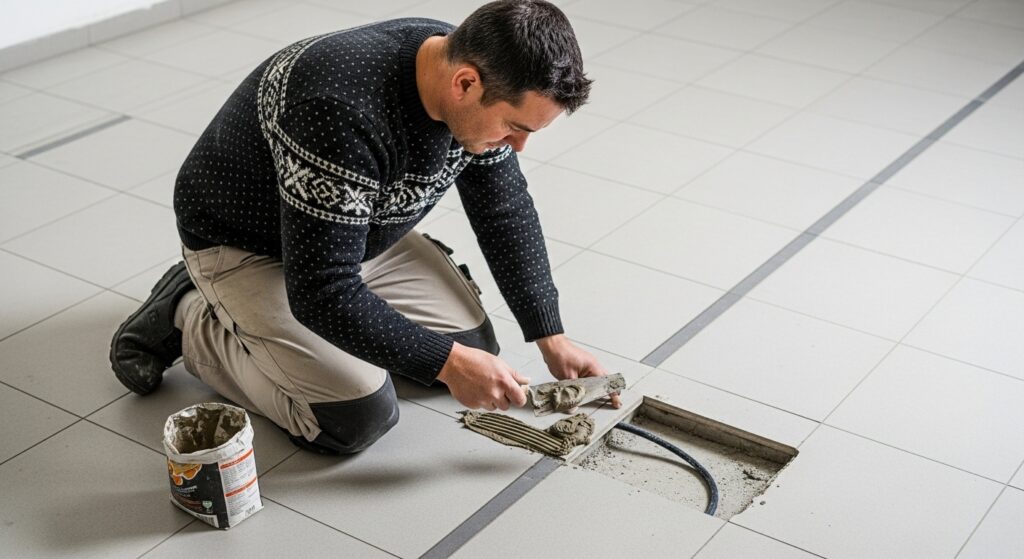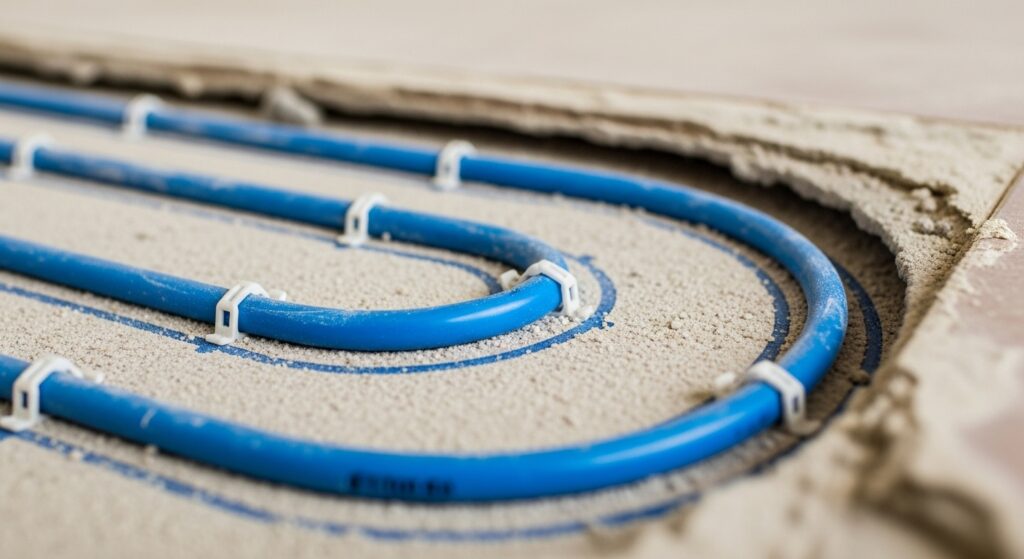Underfloor heating has become a sought-after feature in modern UK homes, adding comfort, efficiency, and a touch of luxury. But like all heating systems, faults can occur – and when they do, one of the biggest concerns homeowners have is whether their flooring will need to be ripped up.
Tiles, in particular, are a common worry. They’re expensive, time-consuming to lay, and often part of a carefully designed interior. The thought of having to lift or break tiles just to reach a heating fault can be daunting.
So, is it possible to repair underfloor heating without uplifting tiles? The short answer is: sometimes, yes – but not always. Thanks to advances in diagnostic tools and repair techniques, many problems can now be located and fixed with minimal disruption. However, there are still scenarios where tile removal is unavoidable.
In this guide, we’ll explore how underfloor heating faults are diagnosed, when tiles can be spared, and when they may have to be lifted.

1. How Underfloor Heating Faults Are Detected
Modern heating engineers rarely rely on guesswork. Instead, they use advanced tools to locate the problem with precision:
- Thermal imaging cameras: Show heat distribution across the floor, helping identify cold patches where a cable is broken or a pipe is blocked.
- Resistance and continuity testers: Used for electric systems to pinpoint breaks in the circuit.
- Moisture meters and pressure tests: Used for hydronic (water-based) systems to locate leaks or drops in pressure.
These technologies mean engineers can locate the exact spot of the fault without lifting large sections of flooring. In many cases, this significantly reduces or even eliminates the need to remove tiles.
2. Situations Where Tiles Don’t Need to Be Uplifted
In some repair scenarios, tiles can remain intact:
- Thermostat or control unit issues: If the fault lies with the thermostat, wiring, or control panel rather than the floor heating element, no tiles need to be disturbed.
- Edge-of-room faults: If the break in a heating cable or pipe is near the room edge, engineers may be able to access it by carefully removing skirting boards or using wall entry points.
- Repairs through grout lines: In some cases, engineers can access heating elements by removing grout between tiles rather than the tiles themselves, then resealing afterwards.
- Manifold or pump repairs: For water systems, many faults occur at the manifold or pump rather than within the floor itself.
In these cases, repairs can be carried out with little or no disruption to your flooring.
3. Situations Where Tiles May Need to Be Lifted
Unfortunately, there are times when tile removal is unavoidable:
- Cable or pipe damage beneath tiles: If a heating cable has broken or a water pipe is leaking in the middle of a tiled floor, access to that spot is essential.
- Widespread system failure: Large-scale faults affecting multiple areas of the floor often require partial tile removal to identify and repair the root cause.
- Poor original installation: If the heating system was incorrectly installed (e.g., insufficient spacing, inadequate insulation), repeated failures may necessitate lifting tiles to correct the underlying issue.
While this can be disruptive, professional engineers take care to lift only the minimum number of tiles required – often just one or two.
4. Can Tiles Be Reused After Removal?
One of the biggest homeowner concerns is whether tiles can be salvaged. The answer depends on the type of adhesive used and how carefully they can be removed.
- Ceramic and porcelain tiles: These can sometimes be lifted intact with the right tools, especially if installed with flexible adhesive.
- Natural stone tiles: More prone to cracking during removal, though experienced engineers may still be able to save them.
- Spare tiles: Having a few spares left over from the original installation makes the process much easier, as damaged tiles can be replaced seamlessly.
If you don’t have spare tiles, it may be worth sourcing matching replacements before scheduling a repair.
5. Minimising the Risk of Tile Removal
While not every repair can avoid tile disturbance, there are steps you can take to reduce the likelihood:
- Arrange annual servicing: Catch small issues early before they escalate into faults under flooring.
- Use professional installers: A properly installed system is less prone to mid-floor faults.
- Invest in quality materials: Higher-grade heating mats, cables, and pipes are more durable and less likely to fail.
- Act quickly when issues arise: Addressing cold spots or leaks early can often prevent them from spreading.
6. Real-World Example
A homeowner in Manchester noticed a cold patch in their tiled kitchen floor. Using thermal imaging, an engineer located the problem to a small section near a grout line. By removing only the grout and accessing the cable beneath, they were able to carry out the repair in three hours – with no tile removal needed.
In contrast, another property in London with a leaking water-based system required two tiles to be lifted to access the damaged pipe. Because the homeowner had spare tiles from the original installation, the floor was restored to its original condition without visible disruption.
7. Why Professional Help is Essential
Attempting a DIY repair without specialist tools often means unnecessary tile removal – and potentially more damage to both the heating system and flooring. Professionals, however, bring:
- Accurate diagnostics to minimise disruption.
- Specialist repair kits for electric cables and mats.
- Experience in careful tile lifting and replacement.
This expertise makes the difference between a simple half-day repair and a full-scale floor replacement.

Conclusion
So, is it possible to repair underfloor heating without uplifting tiles? In many cases, yes – especially when the fault lies outside the floor or can be accessed through grout lines or wall edges. However, some faults, particularly broken cables or leaking pipes under tiles, do require limited tile removal.
The key is professional diagnosis. With modern tools and experienced engineers, the process is far less disruptive than many homeowners fear. And with spare tiles on hand, even necessary tile removal doesn’t have to spoil the look of your flooring.
If your underfloor heating develops a fault, don’t panic. Call a professional engineer, and you may be pleasantly surprised at how little disruption is needed to get your system running again.



